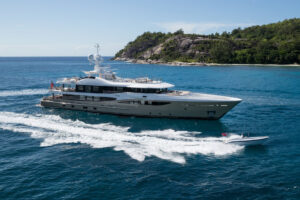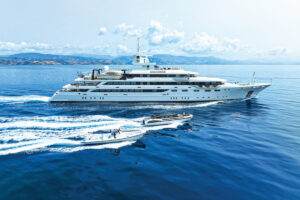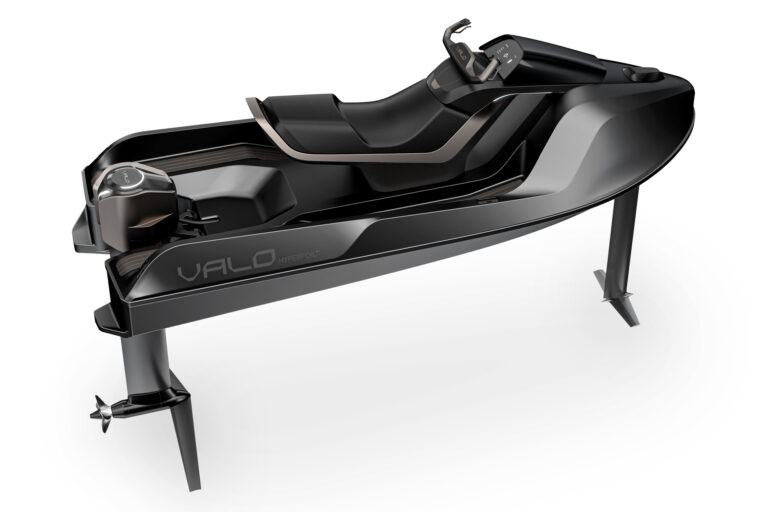Ireland is a country of contrasts, an enigma of rolling hills the color of emeralds, pastures dotted with gaggles of gray sheep and spotted cows, half-width byways pinched between tall hedgerows, and bleak but tidy villages of gray stone houses and shops.
Cloudy skies spit rain to nourish the brilliant greens of summer. Shafts of life-giving light and warmth rocket through cracks and holes in the cloud cover, painting scenes of vivid color against a backdrop of steely gray cumulus.
At every stop, smiling faces breathe toasty welcomes.
To cruise the vascular waterways of Ireland’s abdomen, as I did last June, is to discover the heart and soul of change, a new respect for the past and a thoughtful reach for the possibilities of the future. Here, among the green hills and ruins of castles and cathedrals built more than 800 years ago, a divided nation has begun to reclaim its place in the world. As you might expect, tourism is one of the industries to have benefited.
I was among a handful of journalists who toured part of the Shannon-Erne Waterway, beginning at Killaloe on the southern tip of Lough Derg. (Lough is Gaelic for “lake.”) Although we wouldn’t get to the boats until the afternoon of the following day, Killaloe gave us a taste of 21st-century Ireland.
Forget corned beef and cabbage. Irish chefs who care about their profession are as good as any I’ve experienced. Our hosts that first evening were Ruairi (pronounced “Rory”) Gibbons and Olivia Power, skipper and chef, respectively, aboard the canal barge Shannon Princess. Dinner aboard erased all my misconceptions about Irish food. Power served slivers of home-cured beef fillet with noodles of dilsk seaweed, drizzled with horseradish vinaigrette. A variety of breads followed. One type of puff-ball roll, the blahs, was so light and tasty, I couldn’t stop eating. A sorbet of rosemary and apple cleared our pallet for the hot buttered lobster and shrimp served with herb-flavored grilled polenta and seared ratatouille. A platter of Irish farmhouse cheeses prepared us for the dessert of Bailey’s liqueur ice cream in a toile basket and a miniature crème bruleé with bitter chocolate sauce.
If this meal set the culinary tone for the duration of our tour, the mini-bus transfer to the boats did the same for our itinerary. Although the tour had been superbly engineered by Debbie Petermann of Le Boat Inc. and the Irish Board of Tourism, schedules are meant to be violated in the honor of whims and fancies. The bus ride added a few wrong turns, which delighted me to no end because I got to see more of the countryside and villages than was possible along the waterway.
Some of the villages are little more than a few blocks long by a few wide, and they wear a frown of gray-brown structures bordering streets of undulating tarmac. The sidewalks are narrow and disheveled, but the faces of folks trodding on them are as bright and cheery as the morning sun. Pastel smiles in shades of green, pink, coral and yellow appear on a few of the houses and shops, and the warm colors reflect the populace’s feelings of hope for the future.
We continued toward Keshcarrigan to meet our three waterway cruisers. The fleet waited for us at Castlefore Lock, L8, each member peacefully resting against its fenders with mooring lines slack because current in the waterway is negligible along most of its length. At first, the sight of relatively conventional boats disappointed me; I had dreamed of genuine low and narrow barrel-top canal boats of the sort that many years ago carried freight across most of Europe’s inland waterways. Of course, I got over it.
Two of the boats, both class-Lake Star, came from the charter company Emerald Star. The third, a class-Inver Countess, came from the Aghinver Boat Company charter fleet. The Lake Star boats have a private double stateroom with head in the forepeak and a similar stateroom back aft. The bridge saloon amidships converts to a single port side and a double opposite, and it separates the staterooms by enough distance to guarantee acceptable privacy. The galley is opposite the forward head. The Inver Countess has three private doubles. The forward one has a head opposite the galley; the after ones share a head, which has the MSD and sink to port, the shower to starboard. Both boats are roomy and comfortable, even in the cool rainy weather that dominated the first leg of our tour, because each has a central heating system.
Governors limit the top speed of these single-screw cruisers to about 8 knots to preserve the integrity of the shoreline along the narrow canal and the well-being of the civilian skippers and crew. I skippered the Inver Countess, which is about 35 feet LOA with a 12-foot beam. Her response to the throttle and rudder was casual; the rudder was too small and the prop didn’t give enough thrust. A reasonable level of anticipation let me avoid close calls (and the embarrassment that goes with them) as we motored forward, but backing the boat was another story. She backed to port, no matter what I did, and straightened only when I had enough sea room to run at top speed in reverse. Then she would finally settle down and go where I asked. In tight quarters, backing always resulted in a 360, within her own length, thank God, which I accomplished with a great deal of backing and filling at full throttle. My antics were good for a laugh from the other boats in our party, spectators ashore and, of course, my boat-mate, Petermann.
A short while after we got under way, the waterway scenery made me forget the nature of our conveyance. Verdant fields, some framed by neat rows of trees, rolled to the horizon from either shore. Although sheep and cattle aimlessly grazed here and there, none of the fields was cultivated with edible produce. The soil, depleted more than a century ago, is too acidic for the customary food crops, though wool and dairy products figure strongly in the economy. Layers of peat form the substrata of the Midlands, and in addition to making the soil acidic, the peat turns the waters an uninviting brown-the color of strong tea. This is not pollution, mind you, but simply one of nature’s quirks.
Fishing for food and sport is popular along the waterway, and as it widens into a number of lakes, Garadice Lough in County Leitrim, for example, knots of anglers line the shore. Many sat beneath an umbrella on a small wooden platform made for fishing. Rain is part of life in Ireland, and the residents have learned to peacefully coexist with it. The wise visitor will have a bag full of sea boots, medium-weight foulies and polyester layers to wear beneath. Although each of our boats had an inside helm, I preferred the flying bridge, rain or shine. Yes, we had our share of shine, too-most of each day following the second day.
If you have a tendency to be in a hurry, you’ll have to adjust to the waterway’s slow pace. Our cruise from L8 to L4 at Aughoo, a short distance north of Ballinamore, took about three hours. Traffic was light, but we had to count on 15 to 20 minutes for each lock, longer if we had a boat in front of us or one locking through in the opposite direction.
The procedure couldn’t be easier. Although these locks were built in the mid-19th century, they are electronically controlled. For each drill, I dispatched a crew member with the card key to man the control. We were losing elevation on our route north, so most of the locks were open. Our fenders were permanently deployed, so we entered the lock and belayed the bow and stern lines while the lock operator pushed a button to close the doors and evacuate the water. If you put two crew ashore, you may belay the mooring lines to the boat while the shore crew let out line as the water level lowers.
When Petermann and I locked through, she operated the control and manned the bowline. I manned the stern line, which was belayed to a cleat ashore, so I could feed out line from my station aboard. When the water reached its lowest level, Petermann pushed another button to open the gates, tossed the bowline aboard, let go the stern line and descended the ladder to the boat or waited at the landing immediately outside the lock.
Locking through often drew small crowds of spectators, even at the locks in the wilderness. Maybe these folks vicariously traveled the waterway as they helped with lines or volunteered to operate the control. In one town, a young family of five, two of the children dressed for their First Holy Communion, couldn’t resist the attraction of our flotilla. Jolly greetings and a great eagerness to help charmed us into wishing we could stay and chat.
No one should cruise the waterway without visiting Inishcorkish in Northern Ireland. Our host, John Rehill, is the last native-born islander on Lough Erne. A robust and jolly man grown thick in the middle with advancing age, he and his wife own and run a tiny restaurant on the island. Marked only by a sign that reads “Licensed Restaurant” and artfully disguised as a clump of trees, the restaurant’s only approach is by boat. Nevertheless, the place is always busy during the season. We shared the dining room with a quartet of German tourists and a few locals. After a dinner of salmon, potatoes and veggies, and a dessert of Rehill’s famous Irish coffee, the man himself spun yarns and fiddled traditional Irish tunes. His lust for the simple life warmed us like a peat fire on a snowy night.
Nowhere, though, was the resiliency of human spirit more strongly evident than at Enniskillen, Northern Ireland. The city lies a short distance as the crow flies north of the border between Northern Ireland and the Republic of Ireland. In 1987, an IRA bombing killed 11 residents. That’s a small number amid the turmoil in Northern Ireland, but the incident devastated this relatively small town. A monument that marks the spot, instead of encouraging anger, seems to strengthen the notion that continuing the hostilities in Northern Ireland won’t do anything for the country’s growth. The goal is to establish a lasting peace and get the warring factions to work as a team toward economic development. A well-educated and eager work force promises a bright future, which has attracted a variety of clean, high-tech industries. A walking tour of the city should include the Enniskillen Castle, St. Macartin’s Cathedral, Town Hall, Buttermarket Craft and Design Center, and Blake’s pub, the oldest in all of Northern Ireland, legend has it.
Be sure to smile and say hello to the locals. You’ll find them open and engaging, the best source of insight into the country’s real character.
Our cruise ended on the island of Lusty Beg in Lower Lough Erne-lower meaning downstream-not far from Donegal on the North Atlantic. A bus transfer to Dublin and the airport sent us home. Thus ended my first trip to Ireland and Northern Ireland. I fell in love with the people, their sense of humor, their eagerness to make travelers feel at home, their strength and endurance in the face of economic and political turmoil, and their undying optimism. Our orchestrated tour, though, left me wanting more time to absorb the culture and make friends.
If you go, and I think you should, remember to slow down and open your heart and mind to a pair of countries on the move.
Contact: Le Boat Inc., (201) 560-1941; (800) 992-0291; fax (201) 560-1954; leboatinc@worldnet.att.net; www.leboat.com. The weekly rate for Lake Star varies from $1,360 to $1,950, depending on the season. The largest class boat varies from $2,050 to $2,990, depending on the season. A dinghy, bicycles and airport transfer are extra.








